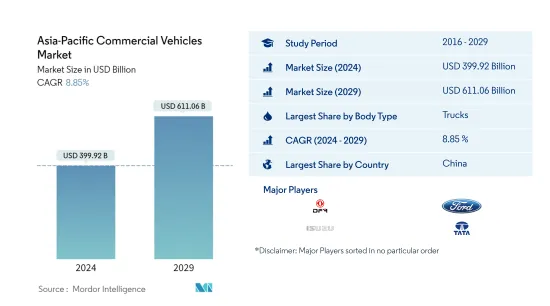Need help finding what you are looking for?
Contact Us
PUBLISHER: Mordor Intelligence | PRODUCT CODE: 1441524

PUBLISHER: Mordor Intelligence | PRODUCT CODE: 1441524
Asia-Pacific Commercial Vehicles - Market Share Analysis, Industry Trends & Statistics, Growth Forecasts (2024 - 2029)
PUBLISHED:
PAGES: 342 Pages
DELIVERY TIME: 2-3 business days
SELECT AN OPTION
The Asia-Pacific Commercial Vehicles Market size is estimated at USD 399.92 billion in 2024, and is expected to reach USD 611.06 billion by 2029, growing at a CAGR of 8.85% during the forecast period (2024-2029).

Key Highlights
- Largest Segment by Fuel Type - Gasoline : The majority of sales across all fuel categories were diesel-fueled CV, as diesel is the traditional fuel engine, generates more power, and is easy availability is a must in commercial usage.
- Fastest-growing Segment by Fuel Type - HEV : The norms introduced by the government, awareness of e-mobility, development in charging infrastructure and incentiveS is making BEV as fastest growing fuel type in the APAC commercial vehicle market.
- Largest Country market - China : China has witnessed the largest share in APAC commercial vehicle sales due to the growth in construction, the eCommerce sector, and logistics activities over the past few years.
- Largest Segment by Body Type - Trucks : The demand for light commercial cars is growing continuously owing to the expanding logistics and e-commerce sectors and development in construction activities.
China is the largest segment by Country.
- Trade channels have been opened due to the relocation of industrial output to Asia, particularly China, which has indirectly benefited the market for commercial vehicles and the logistics sector. Due to the expansion of the logistics and e-commerce sectors, there will certainly be a rise in the demand for LCVs. The expanding Chinese economy has given the middle class in China more disposable income. This has a favorable effect on the rising demand for both commercial and passenger automobiles. Due to the low cost of production in the nation, the demand for automobile production has significantly increased over the past five years.
- The COVID-19 outbreak has prevented the growth of the Asia-Pacific commercial vehicle sector because of restrictions on commerce and travel imposed by the local authorities. Due to the local COVID-19 outbreak, commercial vehicle sales plummeted. As a result of the COVID-19 pandemic, shoppers are seeking low-cost goods, which is changing the local commercial vehicle market.
- Despite numerous obstacles to the adoption of EVs, the Government of India is aiming to develop a shared, connected, and electric mobility option. Such efforts will surely spur the expansion of commercial vehicles in the long run. Governments in Asia must invest USD 26 trillion in infrastructure by 2030, which will substantially facilitate the transportation of building supplies and machinery throughout the continent. Strict pollution rules prompted automakers (OEMs) to switch to electric vehicles. As they learn more about the future of mobility, modern start-ups and entrepreneurs are increasingly choosing commercial electric vehicles as their top option.
APAC Commercial Vehicle Industry Overview
The Asia-Pacific Commercial Vehicles Market is fragmented, with the top five companies occupying 28.45%. The major players in this market are Dongfeng Motor Corporation, Ford Motor Company, Isuzu Motors Ltd, Tata Motors and Toyota Motor Corporation (sorted alphabetically).
Additional Benefits:
- The market estimate (ME) sheet in Excel format
- 3 months of analyst support
Product Code: 93009
TABLE OF CONTENTS
1 EXECUTIVE SUMMARY & KEY FINDINGS
2 REPORT OFFERS
3 INTRODUCTION
- 3.1 Study Assumptions & Market Definition
- 3.2 Scope of the Study
- 3.3 Research Methodology
4 KEY INDUSTRY TRENDS
- 4.1 Population
- 4.2 GDP
- 4.3 CVP
- 4.4 Inflation Rate
- 4.5 Interest Rate For Auto Loans
- 4.6 Battery Price (per Kwh)
- 4.7 Logistics Performance Index
- 4.8 Electrification Impact
- 4.9 New XEV Models Announced
- 4.10 Charging Stations Deployment
- 4.11 Regulatory Framework
- 4.12 Value Chain & Distribution Channel Analysis
5 MARKET SEGMENTATION
- 5.1 Vehicle Type
- 5.1.1 Commercial Vehicles
- 5.1.1.1 Buses
- 5.1.1.2 Heavy-duty Commercial Trucks
- 5.1.1.3 Light Commercial Pick-up Trucks
- 5.1.1.4 Light Commercial Vans
- 5.1.1.5 Medium-duty Commercial Trucks
- 5.1.1 Commercial Vehicles
- 5.2 Engine Type
- 5.2.1 Hybrid And Electric Vehicles
- 5.2.1.1 By Fuel Type
- 5.2.1.1.1 BEV
- 5.2.1.1.2 FCEV
- 5.2.1.1.3 HEV
- 5.2.1.1.4 PHEV
- 5.2.2 ICE
- 5.2.2.1 By Fuel Type
- 5.2.2.1.1 CNG
- 5.2.2.1.2 Diesel
- 5.2.2.1.3 Gasoline
- 5.2.2.1.4 LPG
- 5.2.1 Hybrid And Electric Vehicles
- 5.3 Country
- 5.3.1 Australia
- 5.3.2 China
- 5.3.3 India
- 5.3.4 Indonesia
- 5.3.5 Japan
- 5.3.6 Malaysia
- 5.3.7 South Korea
- 5.3.8 Thailand
- 5.3.9 Rest-of-APAC
6 COMPETITIVE LANDSCAPE
- 6.1 Key Strategic Moves
- 6.2 Market Share Analysis
- 6.3 Company Landscape
- 6.4 Company Profiles
- 6.4.1 BYD Co. Ltd
- 6.4.2 Daihatsu Motor Co. Ltd
- 6.4.3 Dongfeng Motor Corporation
- 6.4.4 Fiat Chrysler Automobiles
- 6.4.5 Ford Motor Company
- 6.4.6 Hino Motor Ltd
- 6.4.7 Honda Motor Company
- 6.4.8 Hyundai Motor Company
- 6.4.9 Isuzu Motors Ltd
- 6.4.10 Mahindra & Mahindra
- 6.4.11 Mitsubishi
- 6.4.12 Scania AB
- 6.4.13 Tata Motors
- 6.4.14 Toyota Motor Corporation
7 KEY STRATEGIC QUESTIONS FOR VEHICLES CEOS
8 APPENDIX
- 8.1 Global Overview
- 8.1.1 Overview
- 8.1.2 Porter's Five Forces Framework
- 8.1.3 Global Value Chain Analysis
- 8.1.4 Market Dynamics (DROs)
- 8.2 Sources & References
- 8.3 List of Tables & Figures
- 8.4 Primary Insights
- 8.5 Data Pack
- 8.6 Glossary of Terms
Have a question?


SELECT AN OPTION
Have a question?


Questions? Please give us a call or visit the contact form.
